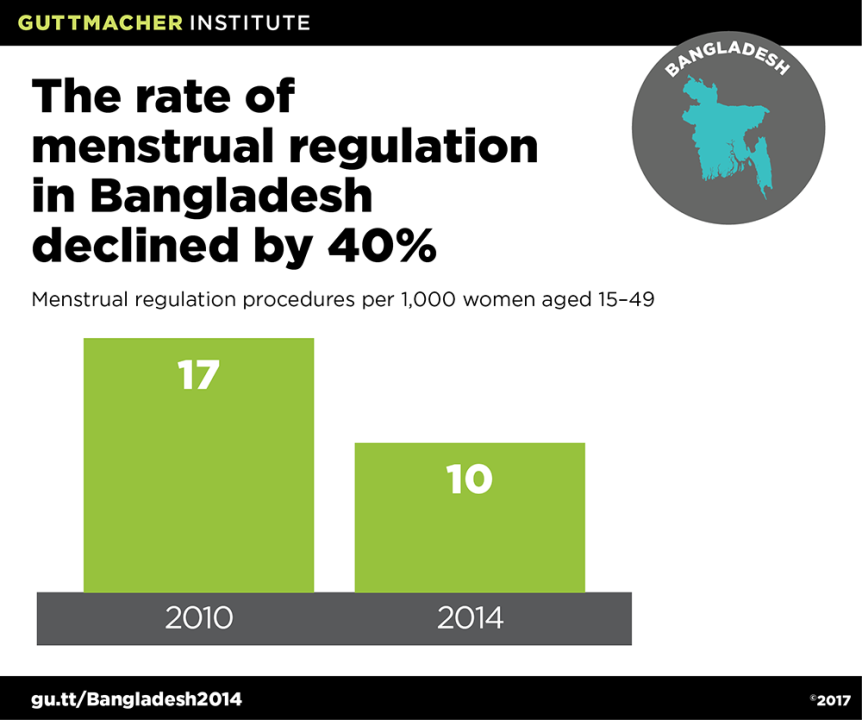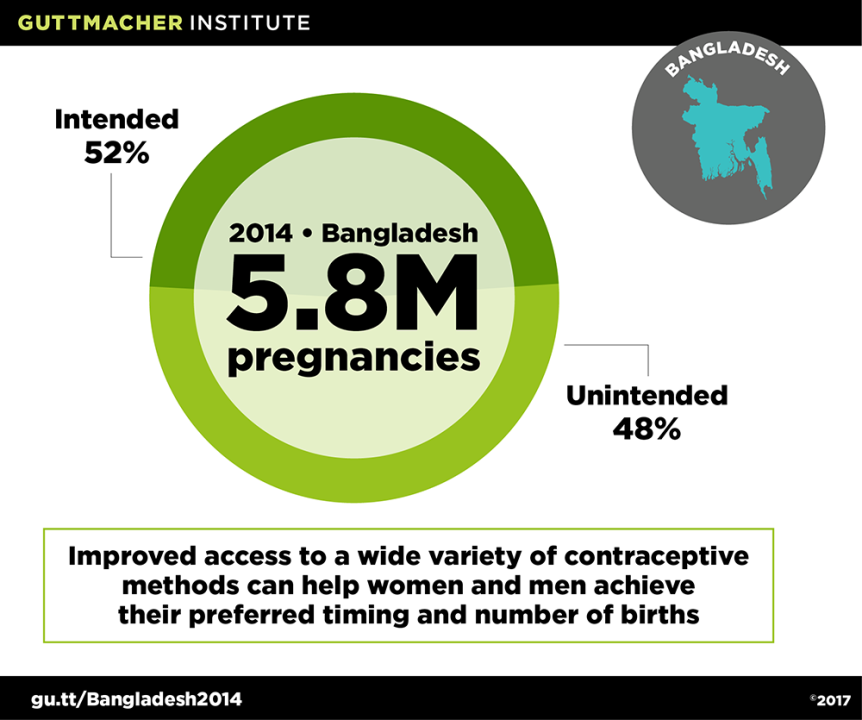Menstrual regulation (MR), a process to regulate or reestablish the menstrual cycle when menstruation is absent for a short duration, has been part of the national family planning program in Bangladesh since 1979. According to two new studies by researchers from the Guttmacher Institute and the Association for Prevention of Septic Abortion, Bangladesh (BAPSA), 430,000 MRs were performed in Bangladesh in 2014 and the rate of MR procedures was 10 per 1,000 women aged 15–49. These figures represent a 34% decline in the number of MRs and a 40% decline in the MR rate since data were last collected, in 2010. Inadequate access to needed MR services may help to explain the declines: The studies show that the proportion of both public and private facilities providing MR services dropped between 2010 and 2014. Among types of facilities that could potentially provide MR, 47% of public and 80% of private facilities in 2014 did not offer that service.
Misinformation among providers and patients may also contribute to decreased access to MR. Twenty-seven percent of all women seeking MR services at public and private facilities were turned away by providers, and although most were turned away for missing the window of opportunity (defined by the number of weeks since their last menstrual period) during which MR is allowed, many providers also reported turning away women for reasons that go beyond government criteria. In addition, there is an important knowledge barrier: According to data from the 2014 Demographic and Health Survey, fewer than half of ever-married women reported that they had ever heard of MR.
In 2014, the government of Bangladesh made several policy changes aimed at improving access to and quality of MR services. The maximum weeks at which a physician could provide MR services was increased, and the government also approved the provision of MR using mifepristone and misoprostol (known as MR with medication, or MRM). Use of MRM was approved just before data collection for this study started; it is an impressive achievement that one-fifth of facilities that provided MR reported offering MRM at that early stage.
"Improving access to MR services is an important first step to expanding availability and improving the quality of these services across the country," says Altaf Hossain, Director of BAPSA. "However, it is important to recognize that without community education and provider training, many women will still remain unaware of or unable to access these critical services."
Drawing on data from a nationally representative sample of health facilities that provide MR or postabortion care services and a survey of health professionals knowledgeable about these services, the researchers also looked at unintended pregnancies in Bangladesh. They found that 48% of the 5.8 million pregnancies in 2014, or 2.8 million pregnancies, were unintended, for a rate of 67 unintended pregnancies per 1,000 women aged 15–49. Fifty-eight percent of unintended pregnancies and 28% of all pregnancies ended in induced abortion and MR, while 30% of unintended pregnancies and 15% of all pregnancies ended in unplanned births.
In Bangladesh, abortion is legal only to save a woman’s life, but the authors found that clandestine abortion remained a serious health problem in Bangladesh between 2010 and 2014. In 2014, there were an estimated 1,194,100 abortions (29 per 1,000 women aged 15–49), and many were likely provided in unsafe conditions or by untrained providers. Some 257,000 women were treated for complications of unsafe abortion in 2014 (six per every 1,000 women aged 15–49), and many more of these women were treated for hemorrhage than in previous studies (27% in 2010 vs. 48% in 2014). The authors speculate that this increase in treatment for hemorrhage could be due to women’s incorrect use of misoprostol (alone or in combination with mifepristone) for clandestine abortion, a method that has become increasingly available at pharmacies and drug sellers.
The authors recommend several steps to make MR services more available to women: increasing provider training and education, including training community-level providers in MR, ensuring facilities that currently offer MR services have the necessary equipment and supplies, expanding the number of facilities that offer MR services, disseminating information about the MR program more broadly at the community level and improving the quality of care in MR facilities. They also recommend measures to reduce complications from unsafe MR and from unsafe abortion, including training drug sellers and paramedics on the proper dosages of misoprostol and mifepristone and encouraging drug sellers to refer women to formal-sector facilities providing MR.
NOTE: Due to improvements in the methodology for the current study’s estimate of illegal abortion incidence, the 2014 estimate is not comparable with the 2010 estimates, so trend data on incidence of induced abortion are not shown.
This news release is also available in Bangla.
For more information see the full articles:
"Access to and Quality of Menstrual Regulation Services and Postabortion Care in Bangladesh: Evidence from Surveys of Health Facilities, 2014," by Altaf Hossain, Isaac Maddow-Zimet, Meghan Ingerick, Hadayeat Ullah Bhuiyan, Michael Vlassoff and Susheela Singh.
"The Incidence of Menstrual Regulation Procedures and Abortion in Bangladesh, 2014," by Susheela Singh, Altaf Hossain, Isaac Maddow-Zimet, Michael Vlassoff, Hadayeat Ullah Bhuiyan and Meghan Ingerick, published in International Perspectives on Sexual and Reproductive Health.

